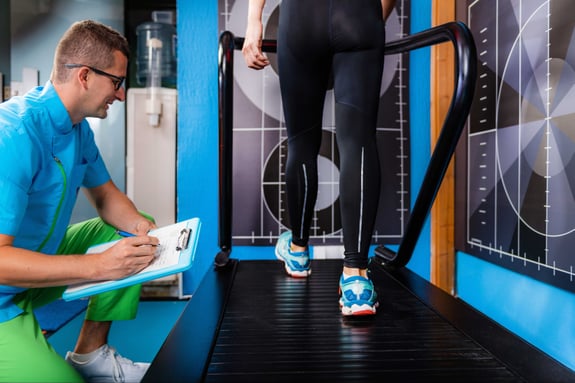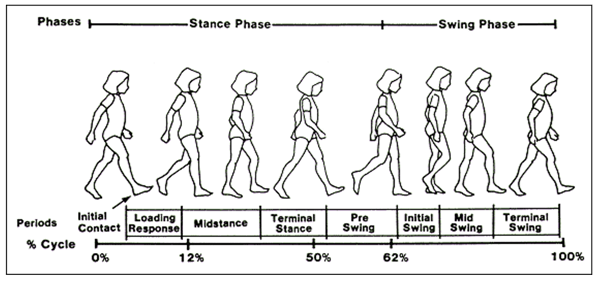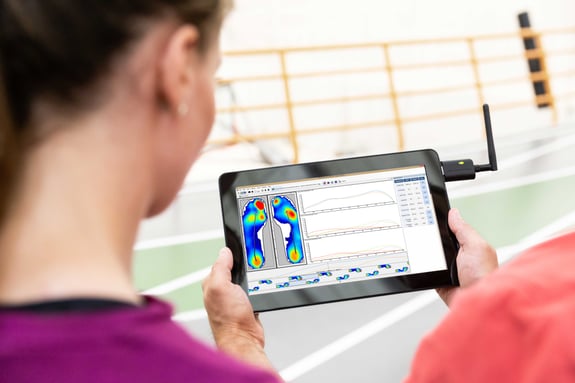
Understanding the Gait Cycle Phases
For optimized human performance, understanding the phases of gait is key.
As humans, the way we walk, step and run is far more than a personalized way of moving. When measured and analyzed properly with the right equipment, the details of a person’s gait phases and plantar pressure give us valuable data. Monitoring gait in a clinical setting, for example, can identify the likelihood of developing diabetic foot ulcers. Similarly, a University research department can optimize athletic performance by studying human movement in the athletic department.
Simply put, gait matters—and finding ways to measure it effectively can improve your practice.
Understanding what comprises gait, along with gait stages and the actions leading up to them, is essential for creating effective treatment plans for patients of all kinds.
What is gait?
The true definition of gait is simple: gait is a person’s manner or style of walking or running. With comprehensive health in mind, the details of one’s gait take on more significance. Gait involves the way someone moves, whether walking, jogging or running. From the speed of the walk to the method of the movement itself, gait showcases everything from neurological readiness to a person’s level of athleticism, making it an essential piece of many health assessments.
There are several components to gait itself, from stance and swing phases to walking and running phases. Comprehensive gait analysis looks at factors including body weight, heel strike, contact with the ground and gait pattern.
We can even define gait as the most fundamental movement pattern related to human locomotion, representing the foundation of any movement screening for different populations ranging from elite athletes to amateur runners and general populations.

Why is gait important?
The Neuromechanics of Human Movement describes human movement as “how the nervous system controls the actions of muscles to exert forces on their surroundings and thereby produce movement.” It’s a complex system involving several subtasks, from complementary tasks where muscles generate and absorb energy to competitive tasks where muscles help to control balance and vertical collapse in the body.
The events that occur from heel strike to heel strike, known as the gait cycle, play a crucial role in human performance—as well as simpler human movement. A person’s gait, which is quite literally the alternating heel strike to heel strike on each side of the leg, can help diagnose any number of issues. By focusing on the importance of gait and then analyzing it with precision, biomechanics researchers, clinicians, physical therapists and other healthcare professionals can identify and solve a host of gait problems.
8 Phases of the Gait Cycle
The eight phases in a complete gait cycle include:
- Initial Contact
- Loading Response
- Midstance
- Terminal Stance
- Pre swing
- Initial Swing
- Mid Swing
- Late Swing

Photo courtesy of Perry, J. (1992)
Within a single gait cycle, there are two primary phases of gait: the stance phase and the swing phase. In the stance phase, which accounts for about 65% of gait movement, the person’s body weight is concentrated mainly on one leg. The swing phase, which accounts for about 35% of the gait movement, involves the change between each leg that naturally occurs during activities like walking or running.
Understanding these phases is essential for a thorough gait analysis.
Phases of Gait: Stance Phase
Gait begins with the stance phase, which includes four main processes:
- Initial Contact
- Loading Response
- Midstance
- Terminal Stance
The step itself, from the time one heel strikes to the time the next makes contact, is not simple at all.
During the initial contact and loading response, the foot makes initial contact with the ground, typically heel first—while the alternate leg poised to swing next remains on the ground. In midstance, the body’s center of gravity is directly over the moving foot before transferring to the supporting foot. In the terminal stance of the gait cycle, the heel makes its way off the ground and into pre-swing.
Approximately 60% of the full gait cycle is spent in the stance phase—the period of the cycle where double limb support is fully on the ground and weight bearing.
During the stance phase, the body is preparing to swing the leg to take a step, which is why it’s so essential to understand.
Initial Contact & Loading Response
The stance phase begins with the loading response, which takes between zero and 10% of the cycle itself. The tibia bone rotates before the femur, which makes room for knee flexion. Loading response occurs while both limbs are on the ground, leading into the next segment of the phase, where body weight is transferred, and the opposite leg is elevated.
Midstance & Terminal Stance
The loading response of the stance phase feeds into midstance and then into terminal stance, taking 10-50% of the cycle in itself. The tibia rotation allows the knee to extend, the tibia-fibula to rotate the ankle joint, and the subtalar joint to supinate. The leg rotates externally around the line of progress. The midstance segment shows the elevation of one limb, and the terminal stance continues until the opposite heel finally reaches the ground.
Phases of Gait: Swing Phase
The swing phase comprises approximately 40-50% of the gait cycle and contains four stages:
- Pre-Swing
- Initial Swing
- Mid Swing
- Late Swing
In simple terms, the swing phase involves the swing of your leg up in the air and then back down while you take a step. It involves your foot clearing the ground, swinging the limb in the air and then preparing the leg to return back to the stance phase.
Understanding the swing phase is essential, as it provides the force to spur movement forward. By pushing your foot and leg off of the ground, the swing phase gives momentum to actually take a step.
Pre-Swing
The swing phase begins with a segment called pre-swing, which takes approximately 60% of the cycle, before transitioning into the swing phase. Also known as the second segment of double limb support, pre-swing relies on the hip flexors to propel the body forward.
Initial Swing
Initial swing, which counts for 10-15% of the cycle, is the beginning of the step, which takes place when the foot leaves the ground and the knee flexes. The hip, knee and ankle engage as the leg rises above the ground. During the initial swing stage, all weight falls to the weight-bearing supporting foot.
Mid Swing
The swing phase then moves into mid swing, which takes 10-15% of the cycle. In mid swing, the supporting leg remains on the ground, while the loading response of the stance phase helps to push the thigh and leg completely above the ground. When you visualize the act of taking a step, you’ll see midswing as the highest point of that step. In human gait, the loading response connects the swing and stance phases, enabling a person to take a full step.
Terminal Swing
The swing phase ends with a segment called terminal swing, which takes another 10-15% of the gait cycle, before reaching the terminal stance with double limb support back on the ground. Terminal swing sees the leg swinging back down, enabling the body to take another step. At the end of terminal swing, the heel strikes back to the ground and makes foot contact so the body can continue the gait cycle. Measuring the time between initial swing and terminal swing helps to determine walking speed.
Gait Phases: Walking
Once you understand the gait cycle, you’ll recognize that the phases of walking are actually made up of the gait cycle itself, repeated.
The stance phase, where the foot makes initial contact, and the swing phase, where the weight-bearing leg leaves the ground, are performed continually until the walk is halted.
Without the elemental knowledge of the gait cycle and by extension, the phases of walking, it would be impossible to analyze how an athlete or an everyday person moves about in their professional and personal life—or how to improve that movement.
Gait Phases: Running
Running is a bit different to walking in terms of the gait cycle. That’s because there are portions in the running cycle where the body finds itself in float, where neither foot is making contact with the ground. The stance phase and the swing phase are still performed during the phases of running, but a float phase sits in the middle.
This is called the “flight phase” and it is usually found only in running and sprinting.
When it comes to running, paying attention to the entire kinetic movement and gait cycle is key. Once you understand every component, you’ll be better equipped to improve multiple issues—everything from stride length to strength. Whether helping an athlete improve running speed or a hobby jogger optimize the way their foot hits the ground, understanding the way the body is meant to run is foundational.
Other Factors for Understanding Gait
Once you have a foundational understanding of these phases, measuring time and speed come into play. The timing of one’s walking and running phases can help you understand the neurological, physical and physiological processes themselves.
How the foot hits the ground when walking or running can also reveal important information. From the heel strike to the toe-off, each individual person walks and runs differently; that variation in gait style can point to issues ranging from center of gravity imbalances and hip misalignment all the way to knee flexion issues or off-balanced weight-bearing.
Since gait helps to absorb shock and keep the body making contact with the ground at the right speed, measuring it matters in both walking and running.
Proper gait is the result of balance between foot function (force transmission and distribution) and coordination of motor skills, being a powerful indicator of overall movement efficiency. The more able we are to effectively transmits the forces produced by the muscles of the lower extremities through the plantar surface of the foot, the more efficient gait and overall movement will be.
XSENSOR: Technology for Measuring the Gait Cycle
XSENSOR has developed gait analysis measuring technology that sets an industry standard for excellence. We understand that assessing and analyzing gait against normative data is a crucial tool across all forms of medicine.
Our proprietary sensor technology allows for higher precision in gait measurement and assessment than any industry competitor, outperforming in both accuracy and repeatability. The capacitive technology used in our sensors presents with lower hysteresis and improved accuracy respect to resistive sensors.
Our durable high-resolution sensors, made specifically for measuring gait and identifying any gait asymmetries, hold up to the strenuous testing required by clinicians, gait researchers, podiatrists and physical therapists, and our Pro Foot & Gait Software is imagery and data-rich with easy-to-use tools and comprehensive analysis.

Sensor resolution and accuracy are crucial to measuring and analyzing gait correctly. Our in-shoe gait analysis sensors are ultra-thin measuring at less than 2mm, making it virtually undetectable, allowing for natural gait while providing the ability for complete and total analysis for both research and athletic performance. Our insoles themselves are proven to be hard-wearing with reliable data, showing 5% or less full-scale error after 100,000 loading cycles.
Each of XSENSOR’s product offerings features dynamic sensing that maintains both reliability and accuracy. These include:
Whichever product you choose, this technology will help you disseminate gait data in a way that works for you, for your providers, and most importantly, for the athletes' and patients’ wellbeing.

